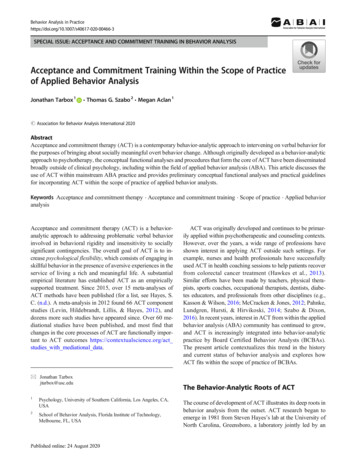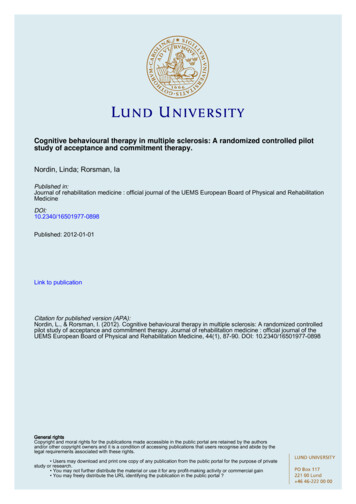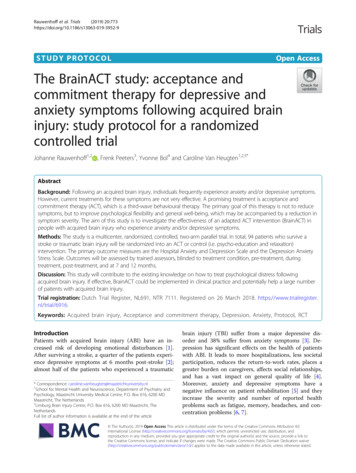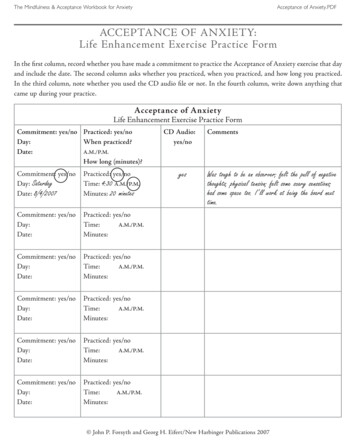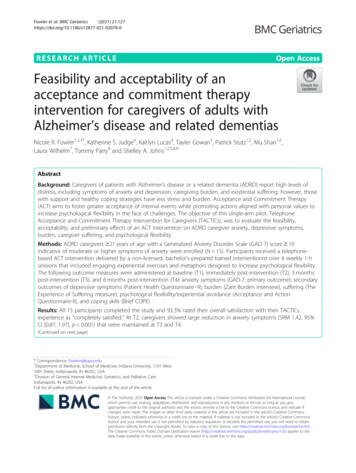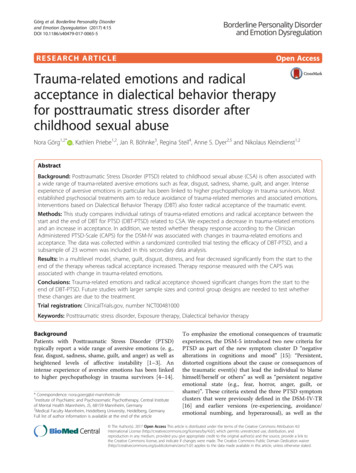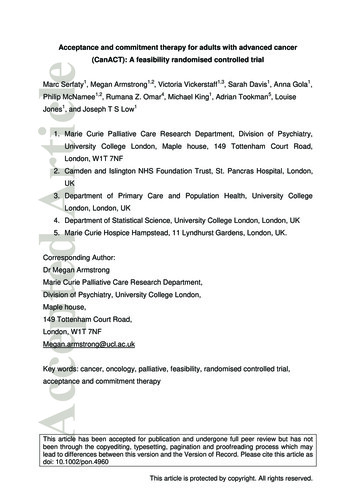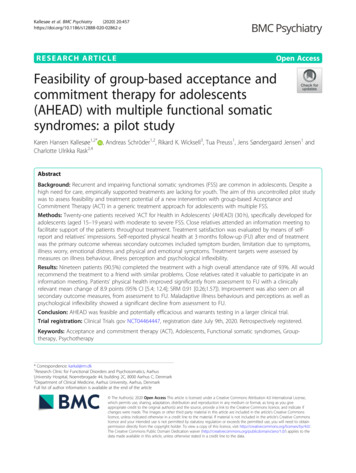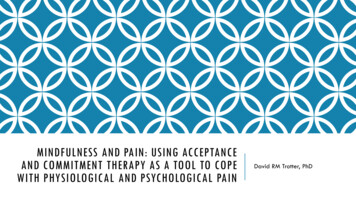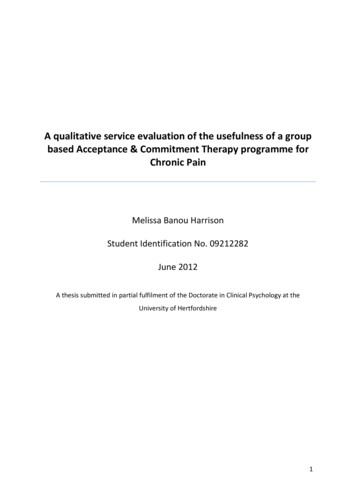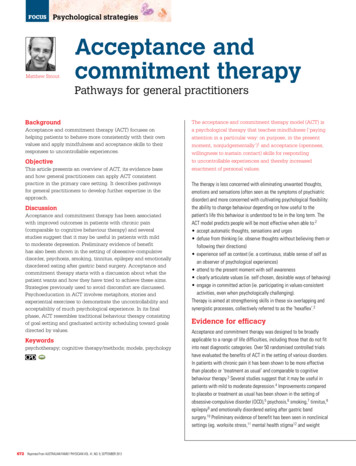
Transcription
Psychological strategiesMatthew SmoutAcceptance andcommitment therapyPathways for general practitionersBackgroundAcceptance and commitment therapy (ACT) focuses onhelping patients to behave more consistently with their ownvalues and apply mindfulness and acceptance skills to theirresponses to uncontrollable experiences.ObjectiveThis article presents an overview of ACT, its evidence baseand how general practitioners can apply ACT consistentpractice in the primary care setting. It describes pathwaysfor general practitioners to develop further expertise in theapproach.DiscussionAcceptance and commitment therapy has been associatedwith improved outcomes in patients with chronic pain(comparable to cognitive behaviour therapy) and severalstudies suggest that it may be useful in patients with mildto moderate depression. Preliminary evidence of benefithas also been shown in the setting of obsessive-compulsivedisorder, psychosis, smoking, tinnitus, epilepsy and emotionallydisordered eating after gastric band surgery. Acceptance andcommitment therapy starts with a discussion about what thepatient wants and how they have tried to achieve these aims.Strategies previously used to avoid discomfort are discussed.Psychoeducation in ACT involves metaphors, stories andexperiential exercises to demonstrate the uncontrollability andacceptability of much psychological experience. In its finalphase, ACT resembles traditional behaviour therapy consistingof goal setting and graduated activity scheduling toward goalsdirected by values.Keywordspsychotherapy; cognitive therapy/methods; models, psychology672 Reprinted From Australian Family Physician Vol. 41, No. 9, september 2012The acceptance and commitment therapy model (ACT) isa psychological therapy that teaches mindfulness (‘payingattention in a particular way: on purpose, in the presentmoment, nonjudgementally’)1 and acceptance (openness,willingness to sustain contact) skills for respondingto uncontrollable experiences and thereby increasedenactment of personal values.The therapy is less concerned with eliminating unwanted thoughts,emotions and sensations (often seen as the symptoms of psychiatricdisorder) and more concerned with cultivating psychological flexibility:the ability to change behaviour depending on how useful to thepatient’s life this behaviour is understood to be in the long term. TheACT model predicts people will be most effective when able to:2 accept automatic thoughts, sensations and urges defuse from thinking (ie. observe thoughts without believing them orfollowing their directions) experience self as context (ie. a continuous, stable sense of self asan observer of psychological experiences) attend to the present moment with self awareness clearly articulate values (ie. self chosen, desirable ways of behaving) engage in committed action (ie. participating in values-consistentactivities, even when psychologically challenging).Therapy is aimed at strengthening skills in these six overlapping andsynergistic processes, collectively referred to as the ‘hexaflex’.2Evidence for efficacyAcceptance and commitment therapy was designed to be broadlyapplicable to a range of life difficulties, including those that do not fitinto neat diagnostic categories. Over 50 randomised controlled trialshave evaluated the benefits of ACT in the setting of various disorders.In patients with chronic pain it has been shown to be more effectivethan placebo or ‘treatment as usual’ and comparable to cognitivebehaviour therapy.3 Several studies suggest that it may be useful inpatients with mild to moderate depression.4 Improvements comparedto placebo or treatment as usual has been shown in the setting ofobsessive-compulsive disorder (OCD),5 psychosis,6 smoking,7 tinnitus,8epilepsy9 and emotionally disordered eating after gastric bandsurgery.10 Preliminary evidence of benefit has been seen in nonclinicalsettings (eg. worksite stress,11 mental health stigma12 and weight
loss13). However, there is room for methodological improvement inthe studies undertaken, in particular by employing follow up periodsof longer than 12 months and controlling for concomitant treatments.Importantly, meta-analyses of its application to a specific disorder,which are required for the National Health and Medical ResearchCouncil Level I evidence of efficacy, have yet to be conducted.However, in the opinion of the author, there is sufficient evidenceto warrant the use of ACT as a psychological therapy, particularly ifthe patient has not responded satisfactorily to a first line cognitivebehaviour therapy protocol and/or the treating therapist has greaterexpertise and experience in ACT than other protocols.Acceptance and commitment therapyAcceptance and commitment therapy typically starts with anassessment of what the patient wants. Emotional control goals(eg. ‘I just want to be happy’) are reframed as a means to a morevalued life (eg. through asking, ‘And if you felt happier and moreconfident what would you be doing more of?’). Assessment includesidentifying all the things the patient has done to try to achieve theiraims and how well these have worked in the short and long term.Acceptance and commitment therapy therapists particularly seek toidentify patterns of trying to control or avoid uncontrollable internalexperiences, particularly those that disrupt valued living. Thesecan range from obvious (eg. overt avoidance of difficult situations,substance use and oversleeping) to subtle (eg. ‘putting on a front’,‘holding back’ or ‘not really listening’ during conversations).Motivation to change is ideally born from an appreciation thatstrategies used until now to reduce discomfort have come at thecost of the life one truly wants.Psychoeducation in ACT consists of metaphors, stories andexperiential exercises to illustrate the uncontrollability andacceptability of much psychological experience and reveal thoughtsto be less powerful and limiting than usually regarded. For example, apatient might be taught to interact with a painful self belief (eg. ‘I’m aloser’) by saying the words out aloud, varying the speed, pitch or tone:treating the stimulus as a sound rather than responding to it literally.To illustrate the difference between struggling to suppress such athought and accepting it, the thought might be written on a card thatthe therapist first pushes toward the patient while the patient pushesit back, then second, places on the patient’s lap, where the patientpractises allowing contact with the thought. Self awareness can bedeveloped by having the patient watch their thoughts and move theirfinger to indicate when thinking drifts into the past or present, insteadof the ‘here and now’. Reasons a patient gives for being unable tochange (eg. ‘I was abused’) might be framed as chapters in a bookof which there are many, none more important than any other. Asreasons for not changing come to mind throughout the day, the patientcan label each as another chapter (eg. the ‘I never finished school’story). Acceptance and commitment therapy encourages patients andtherapists to continually develop new and varied strategies to treatthoughts as harmless and unimportant.In its final phase, ACT resembles traditional behavioural therapyconsisting of goal setting and graduated activity scheduling towardgoals directed by values. Values are made clear and vivid, often assistedwith imagery exercises (eg. ‘Imagine witnessing your 80th birthday partyand hearing the tributes of those who knew you. What would you likethem to say?’). As individuals pursue goals, further unwanted emotionsand thoughts emerge as apparent barriers, to which the acceptance anddefusion skills previously introduced are then applied.While mindfulness meditation (repetitive practice of prolongedattention to present moment sensation) is not incompatible with ACT,neither is it seen as essential. Instead, ACT coaches patients to adoptmindfulness as a quality or attitude with which any planned actionis taken.Applications and contraindicationsAcceptance and commitment therapy may be practised either in a stepby-step, formalised way, or, more typically, in a flexible, principle drivenway. Acceptance and commitment therapy may be offered as self help,individually or in group, as a brief intervention for high functioningpatients or intensively over months for patients with chronic, highlycomorbid presentations. Like any psychotherapy, ACT is not suitablefor people whose cognitive functioning is impaired such that theyhave difficulty comprehending and generating answers to routineassessment questions or virtually no substantive memory of previousconversations. It is not appropriate for individuals who are floridlypsychotic, intoxicated, require emergency medical treatment or haveorganic brain injury.In many trials ACT has been used in conjunction withpharmacotherapy to good effect.5–7 Individuals should have stabletype and dose of any antidepressant, mood stabiliser or antipsychoticmedication before commencing ACT. The use of quick-actingbenzodiazepines (eg. alprazolam or oxazepam) is incompatible withthe ACT aim to reduce experiential avoidance. If individuals areusing the equivalent of more than 15 mg diazepam, a controlledbenzodiazepine reduction regimen is recommended and progress isunlikely to be satisfactory unless individuals are willing to work towardthis. Acceptance and commitment therapy may assist with individualscoping with the discomfort of this reduction, although this has not beenempirically evaluated.ACT resources for the primary careclinicianSee Resources for useful books, websites and a DVD. Simple strategiesthe clinician can employ include: assess the individual’s life context, including relationships, work,recreation and health assess ‘workability’. For example, ask: ‘What have you tried to copewith this problem? How have these strategies worked over time?Have there been any unintended side effects of these strategies?’ assess strengths and weaknesses in the six core ACT processes (asyou would in a mental state examination) (Table 1).Reprinted From Australian Family Physician Vol. 41, No. 9, september 2012 673
FOCUS Acceptance and commitment therapy – pathways for general practitionersTable 1. Proforma for assessing strengths and weaknesses in the six core acceptanceand commitment therapy processesAcceptance of experiences–3Extremelyunwilling,attemptsto avoid alldiscomfort–2Frequentlytries to changeor ,avoidant0Conditionalacceptance:willing to havediscomfortonly underlimitedconditions1Slightlywilling, open2Frequentlywilling tohave difficultexperiencesfor sake ofvalues3Extremelywilling, opento full range ofexperience–2Frequentlyfused: followssubjectiverules asimperatives–1Slightly fused0Defuses withassistancebut notindependentlyand especiallynot e todefuse; onlyhas difficultyunder extremearousal3Extremelydefused:thoughts areepiphenomenaand need notbe acted on–2Frequentlysees no abilityto choose,choosing isaversive–1Slightlyunclear0Can articulatevalues withassistancebut notindependently,especiallywhen conflictswith ‘rules’1Slightly clear2Frequentlyclear how he/she wantsto behave;uncertaintyonly underextremeemotionalarousal3Extremelyclear vision ofhow he/shewants to esor otherwisedisattendsto h past orpresent, ss:able to attendto presentmoment withinstructionand notaroused1Slightly ableto attendto presentmoment onown2Frequentlyable to attendto presentmomentexperience onown unlesshighly aroused3Able to givefull attentionto internaland externalenvironment,in the ‘hereand action: willingto pursuevalues onlyunder vesconsistentwith valuesand onlyinconsistentunder highemotionalarousal3Alwaysbehavesconsistentwith valuesin a broad,diverse rangeof waysDefusion from thought–3Extremelyfused:thoughts seenas factsValues clarity–3No conceptof what’simportant tothemMindfulness–3Constantlypreoccupiedwith worriesabout thefuture orregret aboutthe pastCommitted action–3Behaviourimpulsive,self-defeating;no actiontoward longterm values–2Frequentlybehaviourdictatedby instantgratificationor relief; onlyenacts valueswhen ‘feelslike it’674 Reprinted From Australian Family Physician Vol. 41, No. 9, september 2012
Acceptance and commitment therapy – pathways for general practitioners FOCUSTable 1. Proforma for assessing strengths and weaknesses in the six core acceptanceand commitment therapy processes (continued)Self as context–3–2–10123Extremelyfused withself concept:causalexplanationsabout theself, no selfevaluationsare seen asfacts; there isno distinctionbetween ‘self’and roles,attributes ut theself, and selfevaluations asfactsBehaviour isconstrained byself knowledgeSlightly fusedwith selfconcept andunable toadopt observerperspectiveConditionalability toexperienceself as context:can do soonly withinstructionand when notarousedSlightly able toadopt observerperspective onownFrequentlyable to adoptobserverperspective onown and onlyunable underhigh arousalReadily adoptsobserverperspectiveon experienceand hasstable senseof self greaterthan and notreducibleto specificsensations,traitsTake care not to reinforce societal messages that particular emotions orthoughts need to be eliminated before life enhancing actions can be taken.Model acceptance of uncomfortable life experiences, includingappropriate self disclosure.Model defusing from ‘bossy’/’nagging’/’persuasive’ rules (directionsfrom the mind): again, including appropriate self disclosure (eg. ‘Mymind is always telling me to fit more patients in a day; if I let thatthought dictate my behaviour I would work myself to death, becausethere are always more patients to see. Instead, I might thank my mindfor the suggestion and proceed to work with my planned schedule’).Use defused language when reflecting the patient’s psychologicalexperience (eg. if the patient says, ‘I’m weak’, reflect, ‘You’re havingthe thought ‘I’m weak’’).Ask patients, ‘What’s the next step you could take to live more likethe way you want to in the area of (relationships, work, recreation,health)’ and check their progress in that area the next time you see them.Final wordAcceptance and commitment therapy was designed as a simple, yetpowerful, set of transdiagnostic processes that have broad applicabilityto a range of life difficulties including those that do not fit intoneat diagnostic categories. Its emphasis on the normality of humansuffering, highlighting to clinicians the commonality of experienceshared with patients, has created a training and research communitycharacterised by compassion, supportiveness and creativity that rarelyfails to touch and inspire those who become connected with the work.ResourcesTrainingInterested practitioners can attend introductory workshops, nowregularly available in Australia. Acceptance and commitment therapyworkshops emphasise experiential learning through practisingmindfulness and acceptance of personally uncomfortable thoughtsand emotions. Being trained in ACT has been shown to enhancepsychotherapeutic outcomes even when the practitioner employsother therapeutic approaches,14 so experiencing the principles inaction may help to facilitate ACT consistent interactions with patients,even without additional technique training. The Australian NewZealand chapter of the Association for Contextual Behavioural Science(see below) provides opportunities to further develop skillsBooks Robinson PJ, Gould DA, Strosahl KD. Real behaviour change inprimary care. Oakland, California: New Harbinger, 2011. This bookhas been written for the primary care practitioner and includes ultrabrief (2–5 minute) ACT consistent assessment and interventionguides Good titles for patients include those by Hayes and Smith,15 Forsythand Eifert16 and Dahl and colleagues.17 These have demonstratedefficacy in clinical trialsWebsites The Association for Contextual Behavioural Science (ACBS): www.contextualpsychology.org. Values based dues (pay what you thinkit’s worth) allow you to access demonstration videos, researcharticles, treatment protocols, client handouts and a list of ACTpractitioners The Australian branch of ACBS: www.anzact.com and containsinformation about Australian and New Zealand conferences Russ Harris’ Australian website (www.actmindfully.com) containsclinician handouts, details of upcoming workshops in Australia anda list of ACT practitioners in Australia An international email list for clinicians and researchers to discussnew research and clinical practice is available at mmitmenttherapyDVD ACT in action DVD set: provides clinical demonstrations of therapeutic strategies targeting each of the six ACT processes. Availableat www.newharbinger.com.AuthorMatthew Smout BSc(Hons), MPsych(Clin), PhD, is Team Leader, Centrefor Treatment of Anxiety and Depression, Adelaide, South Australiaand Convenor, Australian Psychological Society Acceptance andCommitment Therapy Interest Group. matthew.smout@health.sa.gov.au.Conflict of interest: none declared.Reprinted From Australian Family Physician Vol. 41, No. 9, september 2012 675
FOCUS Acceptance and commitment therapy – pathways for general 13.14.15.16.17.Kabat-Zinn J. Wherever you go, there you are: mindfulness meditation ineveryday life. New York: Hyperion, 1994.Hayes SC, Strosahl KD, Wilson KG. Acceptance and commitment therapy:the process and practice of mindful change. New York: Guilford, 2011.Website on research-supported psychological treatments. Acceptanceand commitment therapy for chronic pain. Available at hronicpain act.html.Website on research-supported psychological treatments. Acceptanceand commitment therapy for depression. Available at epression acceptance.html.Twohig MP, Hayes SC, Plumb JC, et al. A randomized clinical trial ofacceptance and commitment therapy versus progressive relaxation trainingfor obsessive-compulsive disorder. J Consult Clin Psych 2010;78:705–16.Shawyer F, Farhall J, Mackinnon A, et al. A randomised controlled trial ofacceptance-based cognitive behavioural therapy for command hallucinations in psychotic disorders. Behav Res Ther 2012;50:110–21.Gifford EV, Kohlenberg BS, Hayes SC, et al. Does acceptance and relationship focused behaviour therapy contribute to bupropion outcomes?A randomized controlled trial of functional analytic psychotherapy andacceptance and commitment therapy for smoking cessation. Behav Ther2011;42:700–15.Westin VZ, Schulin M, Hesser H, et al. Acceptance and commitmenttherapy v tinnitus retraining therapy in the treatment of tinnitus: a randomised controlled trial. Behav Res Ther 2011;49:737–47.Lundgren T, Dahl J, Melin L, Kies B. Evaluation of acceptance and commitment therapy for drug refractory epilepsy: a randomized controlled trial inSouth Africa – a pilot study. Epilepsia 2006;47:2173–9.Weineland S, Arvidsson D, Kakoulidis T, Dahl J. Acceptance and commitment therapy for bariatric surgery patients, a pilot RCT. Obes Res Clin Pract2012;6:e21–30.Flaxman PE, Bond FW. A randomised worksite comparison of acceptanceand commitment therapy and stress inoculation training. Behav Res Ther2010;48:816–20.Masuda A, Hayes SC, Fletcher LB, et al. Impact of acceptance and commitment therapy versus education on stigma toward people with psychologicaldisorders. Behav Res Ther 2007;45:2764–72.Lillis J, Hayes SC, Bunting K, Masuda A. Teaching acceptance and mindfulness to improve the lives of the obese: a preliminary test of a theoreticalmodel. Ann Behav Med 2009;37:58–69.Stosahl KD, Hayes SC, Bergan J, Romano P. Assessing the field effectiveness of acceptance and commitment therapy: an example of themanipulated training research method. Behav Ther 1998;29:35–64.Hayes SC, Smith S. Get out of your mind and into your life: the new acceptance and commitment therapy. Oakland, California: New Harbinger, 2005.Forsyth JP, Eifert GH. The mindfulness and acceptance workbook foranxiety: a guide to breaking free from anxiety, phobias, and worry usingacceptance and commitment therapy. Oakland, California: New Harbinger,2008.Dahl J, Lundgren T, Hayes SC. Living beyond your pain: using acceptanceand commitment therapy to ease chronic pain. Oakland, California: New676 Reprinted From Australian Family Physician Vol. 41, No. 9, september 2012Harbinger, 2006.
psychotherapy; cognitive therapy/methods; models, psychology The acceptance and commitment therapy model (ACT) is a psychological therapy that teaches mindfulness ('paying attention in a particular way: on purpose, in the present moment, nonjudgementally')1 and acceptance (openness, willingness to sustain contact) skills for responding
